|
1973 - A new leader and the Police
The success of the flying school and helicopter arms of what was still known as Air Gregory, despite it being taken over by John Delaney and the Medminster Group, led to a new appointment of a managing director in February 1973. John Delaney was a newcomer to aviation, and needed someone who understood the needs of Air Gregory, especially in terms of flying training. In Air Commodore Frederick Oliver "Barry" Barrett, recently retired from the Royal Air Force, he found the ideal man.
|
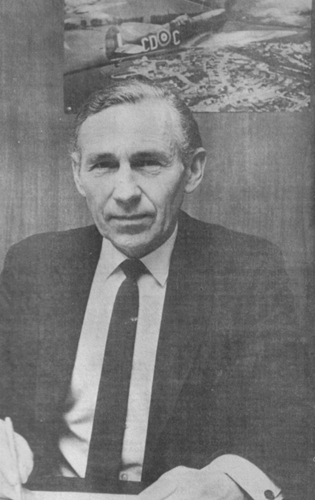
Air Commodore F O Barrett CBE DFC became managing director of Air Gregory in February 1973.
|
Air Commodore Barrett had joined the RAF in January 1938, learning to fly at 11 Flying Training School before being posted to RAF Harwell as a pilot with 226 Squadron. The Squadron was part of the light day bomber force, operating the single engined Fairey Battle three seat bomber. After the German invasion of Poland on 1st September 1939 and the declaration of war on the 3rd, the Squadron moved to France as part of the Allied Air Striking Force and was based in Northern France. Reconnaissance and training sorties were flown over the winter until the German army launched its offensive against France and the Low Countries on 10 May. The Fairey Battle proved no match for the Messerschmitt Bf 109 fighter, and the Squadron was decimated in just two days. Barrett found himself promoted to acting Flight Commander despite his relative lack of experience, the losses were so high. The following day, 13 May, Barrett was leading a flight of three Battles when they were attacked by several Bf 109s. Barrett was hit in the arm and his aircraft badly damaged, but he managed to make a forced landing near a French column and was taken to a French Field Hospital. This was overrun by the Germans but Barrett and several other patients managed to escape, after which he made his way to the mouth of the Loire river and returned to England by ship. His wound had not healed properly, so he spent the next six months in hospital before being posted to South Africa as a flying instructor.
|
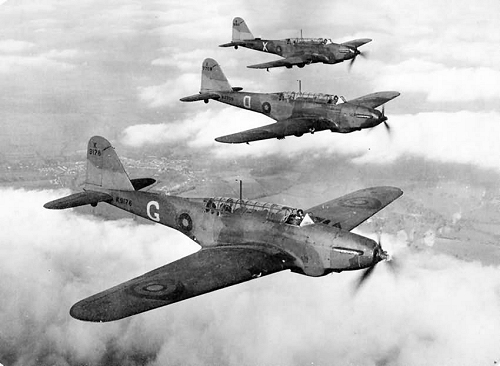
Fairey Battles of 226 Squadron on a practice flight over France in February 1940. The Squadron letters, MQ have been painted out and the national markings have had the white areas removed.
|
After three years as an instructor, in 1944 Barrett was posted back to the UK to fly the de Havilland Mosquito in the interdictor strike role, firstly with 613 Squadron, then with 305 Polish Squadron as a Flight Commander. In April 1945 Barrett, now a Squadron Leader, conducted a roving strike mission in the Bremen/Hamburg area. South East of Bremen, he sighted fifteen railway trucks in a siding and attacked, strafeing them with machine gun and cannon fire. The trucks exploded, blasting his aircraft upside down and badly damaging it with several large pieces of debris that were thrown into the air. Recovering partial control, it seemed the badly damaged Mosquito would have to be abandoned, but Barret had no desire to become a prisoner again. Despite nearly losing control of the aircraft several times, Barrett made it back to Allied captured territory and made a crash landing at an airfield. For this piece of extremely skilled and determined flying, he was awarded the Distinguished Flying Cross.
|
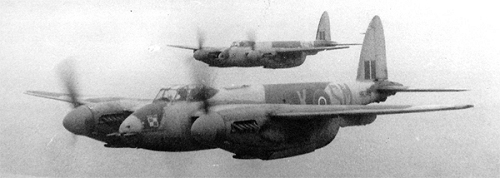
de Havilland dH.98 Mosquito FB Mk.VIs of 305 (Polish) Squadron in 1945.
|
After the Second World War, Barrett was posted to Canada as the Chief Flying Instructor of the Canadian Central Flying School. He was to hold an increasingly senior number of posts in flying training, including as CFI of 5 Flying Training School, before moving into operational planning, ending up as the Senior Air Service Officer of 38 Group. His last role before retiring from the RAF was as the Director Of Flight Safety, so as can be seen, his experience amply qualified Barrett to take over the Air Gregory flying training branches, both fixed and rotary winged. John Delaney, realising the quality of the man he had employed, quickly made Barrett the Aviation Director for the whole Medminster Group, including his flying school at Biggin Hill and other assets.
|

Local press photographer and popular flying club member Paddy Hember, seen here with instructor Mike Stapp just after his first solo in June 1973.
|
As already mentioned in 1971, local press photographer Paddy Hember had begun his private pilots licence course. He had flown so often in Denham based aircraft to take his remarkable pictures of the area that he had developed a taste for flying, so decided to take it up as a member of the Air Gregory School of Flying. He quickly became a popular member of the school, qualifying for his licence later in the year and organising group fly-ins to other airfields in the UK and abroad. Of course, Paddy was also to use his new skills to further his photographic work, recording the majority of Buckinghamshire and its development over three decades.
|

Jean Batten, seen here in 1972 with Edgar Percival, manufacturer of the Percival Gull Six in which she made her record breaking flights to Brazil and New Zealand in the 1930s. Jean opened the GAPAN air display at Denham in 1973.
|
|
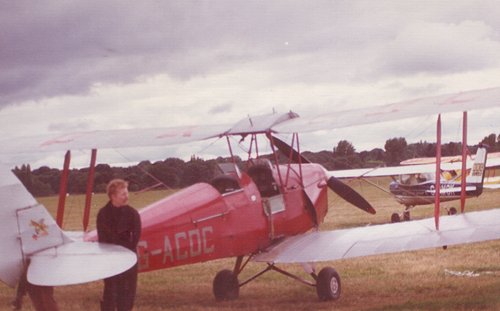
The 1973 GAPAN display was ably supported by the Tiger Club and other organisations, including the Denham based BBC Flying CLub, who's Cessna 150 can be seen between the wings of the Tiger Moth.
|
The year also saw the Guild of Air Pilots and Navigators (GAPAN) return to Denham in August to hold the next in their series of open days and air shows. The Guild were supported by the Tiger Club and several of the organisations based at Denham. Pioneer aviator Jean Batten opened the airshow, her arrival was followed by a day at the aerodrome with many happy reunions with old friends and Guild members. One of the more unusual events was a flour bombing competition that used a vintage car as a moving target! The famous BBC television programme Blue Peter also got involved in the display, giving their audience a pilot's eye view of the exciting limbo pole event, where aircraft of the Tiger Club flew under strings of bunting flags suspended from poles on either side of the runway. As with the other Guild shows at Denham, this was a great success with a large and enthusiastic crowd having a fine day out enjoying the air and ground displays.
| 
Aerodrome founder and owner Myles Bickerton with John Delaney, discussing the concept of the police use of helicopters at the Denham exhibition flights held in 1973.
|
As was mentioned in 1972, the Metropolitan Police Flying Club (MPFC) open day held at the Denham was to have far reaching effects. The Metropolitan Police had been a pioneer in the use of aircraft for direction, observation and crowd control as far back as the 1920s, with airships, autogyros and light aircraft all being used at high profile events. As already recorded in 1957, aircraft from the Denham School of Flying had taken part in experiments with radio direction of ground units and traffic control. Post war a number of Westland Dragonfly and Bristol Sycamore helicopters had been used across the UK's police network to provide aerial support to ground units, but these had proved expensive to operate. In 1964, Hughes Helicopters, in association with a UK dealership had demonstrated the utility of the Hughes Model 300 and 500 helicopters to senior police officers from all over the UK. Political will to develop police air support was lacking at the time so the demonstrations went no further. However, individual police forces pursued their own aviation interests, and when the MPFC held their open day, Air Gregory's helicopter division took the opportunity to show off the capabilities of their fleet. The interest this created led to an official day of demonstrations being held in July 1973, with senior police officers from several forces in attendance.
|
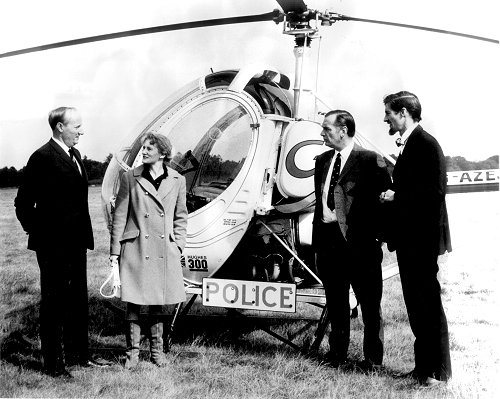
Mike Smith of Air Gregory (furthest right) and aerodrome manager Beatrice Paul (second from left) met with senior police officers to demonstrate the Hughes helicopters of Air Gregory in July 1973.
|
The demonstration flights were to lead to several assessments of helicopter capabilities by police forces over the next few years, some of which involved Air Gregory and its pilots at Denham. Through these trials, individual police forces would further develop their own aviation arms of varying capabilities, before all of these would finally be amalgamated into the National Police Air Service in 2012. The new director of Air Gregory would also create some changes of his own, as will be related next
|
|

